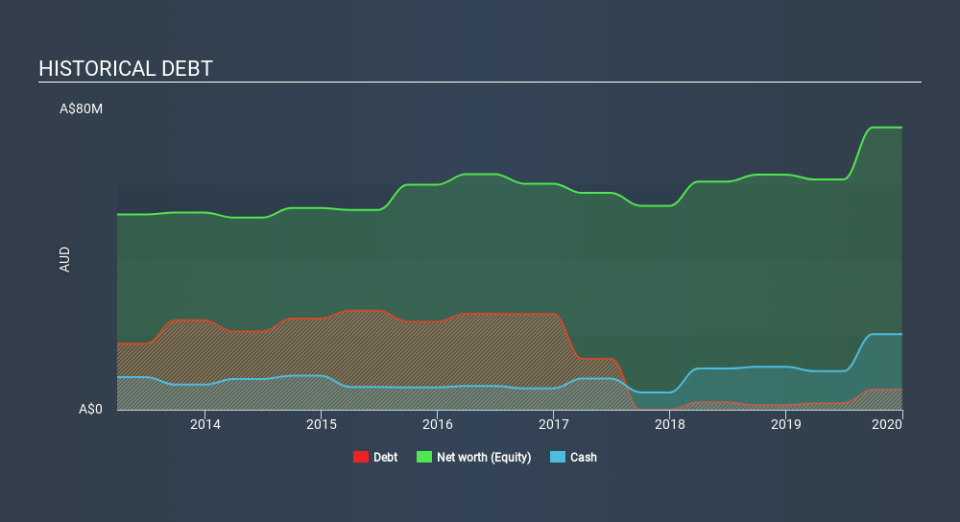Here's Why Countplus (ASX:CUP) Can Manage Its Debt Responsibly

David Iben put it well when he said, 'Volatility is not a risk we care about. What we care about is avoiding the permanent loss of capital. So it might be obvious that you need to consider debt, when you think about how risky any given stock is, because too much debt can sink a company. Importantly, Countplus Limited (ASX:CUP) does carry debt. But should shareholders be worried about its use of debt?
What Risk Does Debt Bring?
Debt assists a business until the business has trouble paying it off, either with new capital or with free cash flow. Ultimately, if the company can't fulfill its legal obligations to repay debt, shareholders could walk away with nothing. However, a more frequent (but still costly) occurrence is where a company must issue shares at bargain-basement prices, permanently diluting shareholders, just to shore up its balance sheet. Of course, debt can be an important tool in businesses, particularly capital heavy businesses. The first step when considering a company's debt levels is to consider its cash and debt together.
Check out our latest analysis for Countplus
What Is Countplus's Net Debt?
You can click the graphic below for the historical numbers, but it shows that as of December 2019 Countplus had AU$5.39m of debt, an increase on AU$1.19m, over one year. However, it does have AU$20.1m in cash offsetting this, leading to net cash of AU$14.8m.
How Healthy Is Countplus's Balance Sheet?
According to the last reported balance sheet, Countplus had liabilities of AU$175.8m due within 12 months, and liabilities of AU$34.4m due beyond 12 months. Offsetting this, it had AU$20.1m in cash and AU$169.7m in receivables that were due within 12 months. So its liabilities total AU$20.4m more than the combination of its cash and short-term receivables.
Since publicly traded Countplus shares are worth a total of AU$127.5m, it seems unlikely that this level of liabilities would be a major threat. Having said that, it's clear that we should continue to monitor its balance sheet, lest it change for the worse. Despite its noteworthy liabilities, Countplus boasts net cash, so it's fair to say it does not have a heavy debt load!
Shareholders should be aware that Countplus's EBIT was down 73% last year. If that earnings trend continues then paying off its debt will be about as easy as herding cats on to a roller coaster. When analysing debt levels, the balance sheet is the obvious place to start. But it is future earnings, more than anything, that will determine Countplus's ability to maintain a healthy balance sheet going forward. So if you're focused on the future you can check out this free report showing analyst profit forecasts.
Finally, while the tax-man may adore accounting profits, lenders only accept cold hard cash. While Countplus has net cash on its balance sheet, it's still worth taking a look at its ability to convert earnings before interest and tax (EBIT) to free cash flow, to help us understand how quickly it is building (or eroding) that cash balance. Over the last three years, Countplus actually produced more free cash flow than EBIT. That sort of strong cash generation warms our hearts like a puppy in a bumblebee suit.
Summing up
While Countplus does have more liabilities than liquid assets, it also has net cash of AU$14.8m. The cherry on top was that in converted 141% of that EBIT to free cash flow, bringing in AU$2.2m. So we are not troubled with Countplus's debt use. When analysing debt levels, the balance sheet is the obvious place to start. But ultimately, every company can contain risks that exist outside of the balance sheet. Be aware that Countplus is showing 3 warning signs in our investment analysis , and 2 of those don't sit too well with us...
Of course, if you're the type of investor who prefers buying stocks without the burden of debt, then don't hesitate to discover our exclusive list of net cash growth stocks, today.
If you spot an error that warrants correction, please contact the editor at editorial-team@simplywallst.com. This article by Simply Wall St is general in nature. It does not constitute a recommendation to buy or sell any stock, and does not take account of your objectives, or your financial situation. Simply Wall St has no position in the stocks mentioned.
We aim to bring you long-term focused research analysis driven by fundamental data. Note that our analysis may not factor in the latest price-sensitive company announcements or qualitative material. Thank you for reading.

